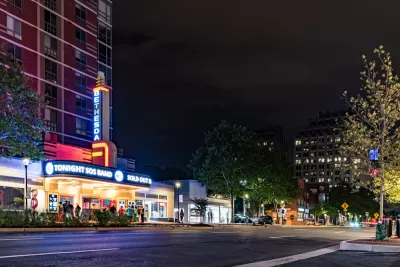The county hasn’t acted on the recommendations of its own Nighttime Economy Task Force, which suggested ways to improve the business climate for restaurants and nightclubs to draw younger residents to the region.

In a piece for Greater Greater Washington, Weston Henry describes how Montgomery County’s business regulations are stifling the development of nightlife in the county.
According to Henry, the Nighttime Economy Task Force, formed in 2013, published a series of recommendations to revitalize the county and bring more residents and businesses to the area. “And yet, here we are eleven years later, with no dance clubs, few late-night spots, and little evidence to suggest that the perception of the county as a social desert for singles has changed.”
Henry blames this on the Board of License Commissioners, which “is solely responsible for creating the county’s alcohol rules and regulations, and have created a series of regulations seemingly designed with the sole intention of preventing any venue catering to young, single, or recently transplanted people to open in the county.” Henry notes that restrictions on restaurants and bars such as requiring that 40 percent of income be earned through food sales, prohibiting dancing in venues without a special license, and requiring a full menu of food are preventing businesses from operating successfully. While the task force recommended a new social venue license, it was never created.
While some local officials say the younger work force will move back to the county after they have kids, this belief, Henry writes, “is a terrible economic strategy. It contributes to our massive labor shortage, which forces employers to eliminate positions, as the county itself did last year, or move to where they can find people to fill these positions.”
FULL STORY: Where’s the nightlife in Montgomery County?

Planetizen Federal Action Tracker
A weekly monitor of how Trump’s orders and actions are impacting planners and planning in America.

San Francisco's School District Spent $105M To Build Affordable Housing for Teachers — And That's Just the Beginning
SFUSD joins a growing list of school districts using their land holdings to address housing affordability challenges faced by their own employees.

The Tiny, Adorable $7,000 Car Turning Japan Onto EVs
The single seat Mibot charges from a regular plug as quickly as an iPad, and is about half the price of an average EV.

Seattle's Plan for Adopting Driverless Cars
Equity, safety, accessibility and affordability are front of mind as the city prepares for robotaxis and other autonomous vehicles.

As Trump Phases Out FEMA, Is It Time to Flee the Floodplains?
With less federal funding available for disaster relief efforts, the need to relocate at-risk communities is more urgent than ever.

With Protected Lanes, 460% More People Commute by Bike
For those needing more ammo, more data proving what we already knew is here.
Urban Design for Planners 1: Software Tools
This six-course series explores essential urban design concepts using open source software and equips planners with the tools they need to participate fully in the urban design process.
Planning for Universal Design
Learn the tools for implementing Universal Design in planning regulations.
Smith Gee Studio
City of Charlotte
City of Camden Redevelopment Agency
City of Astoria
Transportation Research & Education Center (TREC) at Portland State University
US High Speed Rail Association
City of Camden Redevelopment Agency
Municipality of Princeton (NJ)




























